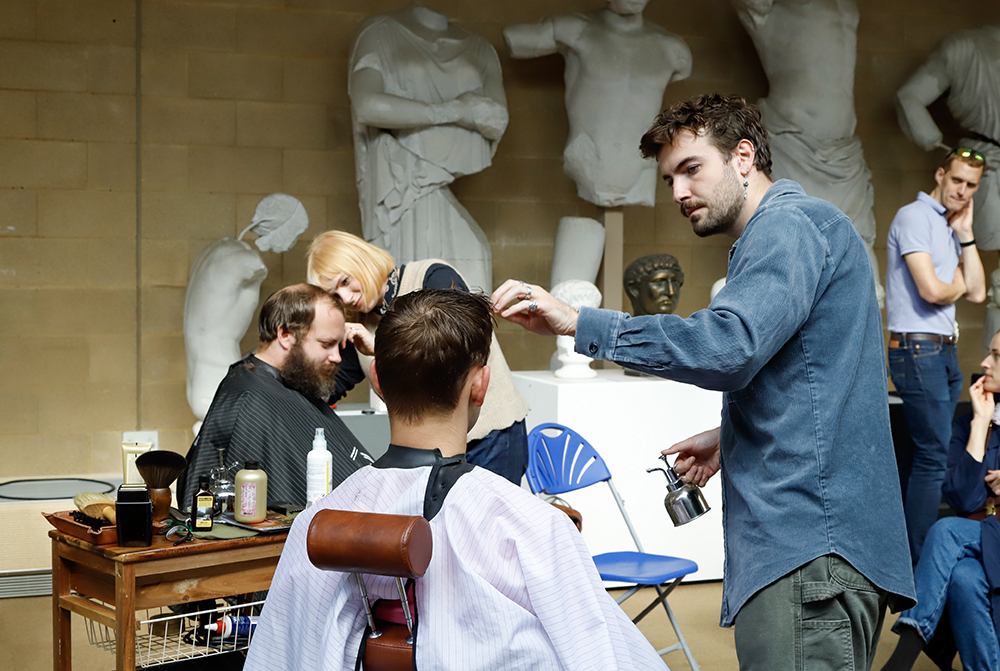Report on the workshop ‘Godly grooming: religion, spirituality, and male hair‘ held in September 2023 at the Faculty of Classics, University of Cambridge.
Some things are so much under our eyes (or on our heads or around our mouths) that we forget, as scholars, to interrogate them. Hair is a good example. We watch it grow and fall, we braid, dye, and shave it. This is as true today as it was in antiquity – grooming techniques (and technologies) might have developed, but the network of emotional and ideological reasons driving the manipulation of the most changeable and renewable of our body parts continue to resonate with constructions of – and concerns with – age, gender, sexuality, ethnicity, spirituality, and exclusion. Yet little has pierced the surface in terms of scholarly engagement with this theme. Excellent individual work exists, but nothing offers a comprehensive assessment of the entanglement between the religions of the pre-modern Mediterranean and hair grooming practices from shaving, adorning, dying, hair cutting, to lock-offering, beard trimming, and more.
Our challenge, as organisers of the first workshop dedicated to exploring the interactions between hair and religion from antiquity to early modernity, was to pursue connections between the seemingly impermanent – what we frequently associate with vanity, appearance, cosmetology – and some of antiquity’s most viscerally resounding debates surrounding belief, divinity, and belonging.
To maximise interdisciplinarity we asked our cross-disciplinary team of international scholars for short pre-circulated papers – 3k words each maximum – and dived straight into discussion. Papers were grouped following the rigorous criterion of scrambling texts and contexts, and we sought respondents whose area of expertise did not overlap with what they were responding to. Cross-fertilisation brought out the polysemic nature of hair grooming to the point that our starting question, ‘how to read hair?,’ was often left open – an openness that, however, we perceived as ridden with potential. We savoured the vitality of exchanges between, say, an early modernist studying Renaissance Florence and a talk on the ancient Alexandrian theologian Clement, or between conversations on the regulation of hair in the Shulchan Aruch, the spirituality of shaving in Rome, or the correlations between beards and heresy in medieval Europe. Discussions tapped into issues from the questioning and policing of identity and otherness (vis-à-vis one’s own religious community, or in front of oneself), desire (of bodies, and how this desire speaks to one’s idea of god), the self as symbol, the construction of masculinity and that of asceticism, angel hair and female hair, the impurity of hairy matter and the divine atemporality of clean-shaven-ness, up to Adam’s beard from the night of times.
On the second day (‘The cutting edge: hierarchies of hair in the Greco-Roman world’) we staged our experiment, an exhibition in two parts (in the morning for the Cambridge Alumni Festival, and in the afternoon as a public event open to all) in the Cast Gallery of the Museum of Archaeology of the Cambridge Classics Faculty. The event would not have been possible without the incredible help and vision of the curator and the director of the Museum, Dr Susanne Turner and Professor Caroline Vout, to whom we extend our deepest thanks. The theme of the day was ‘hierarchies of hair’, an exploration of how Greco-Roman antiquity provides a variety of vivid examples as to how power (and the relationship of power to the divine) was expressed through hair and beard grooming. The exhibit sought to explore hair’s potential to speak to everyone. The barbers from Douce Cambridge reproduced, in live action, iconic hair and beard cuts sported by both elite and lower-class men of the Roman empire, as well as those beyond the boundaries of the Roman Empire, on bearded volunteers, while we offered live commentary. In separate installations, Dr Mary Harlow (University of Leicester) demonstrated the up-dos of Roman women of different ages and social classes, and children were involved in interactive activities from face-painting (of beards), family trails, and hands-on crafts (like paper, wearable beard-making). Numbers were high. 48 people attended the alumni event (45 adults and 3 children) and 65 the public-facing event (49 adults and 17 children).
It was a festive day, and the questions it raised were part of the fun. We hope that sharing our experience on this blog might contribute to two, crucial, ongoing reflections. The first is how, as academics, to shape events involving larger audiences and make them feel welcome in spaces such as a department or a museum. The other is a consideration on how we – again, as academics – construct the marginal in and to our disciplines. Hair quickly revealed itself as a powerful catalyst for transcultural and diachronic conversations, brought a surprising array of people of different ages and interests together, and contributed not only a lens to look at the past somewhat differently, but also an opportunity to reflect on what the past says of ourselves when we look into the mirror first thing in the morning. As the project grows and expand, it is our ambition to engage in exchange with the hair-grooming industry and hair influencers, to reflect in how many ways each can learn from each. Our deepest thanks to CRASSH for their formidable help and support, without which this important first step would have never been taken.
- Written by workshop convenors Lea Niccolai and Dawn LaValle Norman





